Health services across the UK worked hard to try to get services functioning normally throughout the pandemic, and especially when the number of COVID-19 cases fell – a monumental task that could not have been achieved without the hard work and dedication of the staff,” says Jon Shelton, a senior cancer intelligence manager at Cancer Research UK.
But the sustained disruption the pandemic caused throughout 2020 has left a deep rift in cancer care, with 40,000 fewer people starting cancer treatment across the UK last year.
While this figure looks specifically at treatment, it’s largely driven by a drop in the number of people who were diagnosed with cancer in 2020. And it’s worrying, as Shelton explains.
“The number of people diagnosed with cancer or starting treatment in the UK each year is usually relatively predictable. We don’t see large changes within a cancer site year on year unless a big change is introduced, like a new screening programme.” Shelton says there can be fluctuations – for example there was an unusually large increase of about 10,000 prostate cases in 2018 following the high-profile prostate cancer diagnoses of Stephen Fry and Bill Turnbull, but we are usually confident of estimating the overall figure to within a few thousand each year. “So a drop of 40,000 is big.”
So, where are the 40,000 people who would have expected to start cancer treatment, but haven’t? The majority will be in the community, living with cancer without knowing about it, and with the potential that their tumour could grow and spread, they really need to be diagnosed and treated as soon as possible.
Which could pose a challenge for health services.
“How do health services, which were struggling to cope before the pandemic, now cope with this influx of people. Because most of those 40,000 still need to come through on top of the people who would normally be diagnosed in 2021.”







